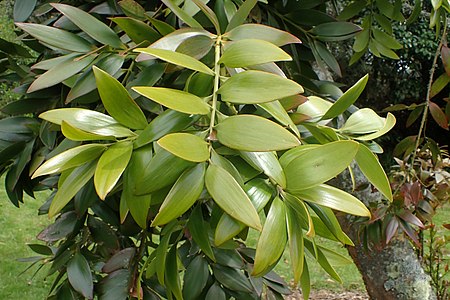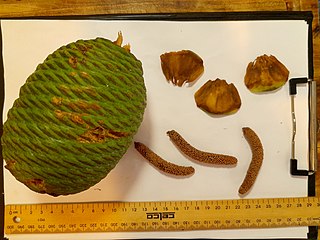
Araucariaceae – also known as araucarians – is a family of coniferous trees, with three living genera, Araucaria, Agathis, and Wollemia. While the family was distributed globally during the Jurassic and Cretaceous periods, in their native distribution they are now largely confined to the Southern Hemisphere, except for a few species of Agathis in Southeast Asia.

Wollemia is a genus of coniferous trees in the family Araucariaceae, endemic to Australia. It represents only one of three living genera in the family, alongside Araucaria and Agathis. The genus only has a single known species, Wollemia nobilis, which was discovered in 1994 in a temperate rainforest wilderness area of the Wollemi National Park in New South Wales. It was growing in a remote series of narrow, steep-sided, sandstone gorges 150 km (93 mi) north-west of Sydney. The genus is named after the National Park.

Araucaria is a genus of evergreen coniferous trees in the family Araucariaceae. While today they are largely confined to the Southern Hemisphere, during the Jurassic and Cretaceous they were distributed globally. There are 20 extant species in New Caledonia, Norfolk Island, eastern Australia, New Guinea, Argentina, Brazil and Chile.

Agathis, commonly known as kauri or dammara, is a genus of evergreen coniferous trees, native to Australasia and Southeast Asia. It is one of three extant genera in the family Araucariaceae, alongside Wollemia and Araucaria. Its leaves are much broader than most conifers. Kauri gum is commercially harvested from New Zealand kauri.

Araucaria bidwillii, commonly known as the bunya pine (, or bunya-bunya, is a large evergreen coniferous tree in the family Araucariaceae which is endemic to Australia. Its natural range is southeast Queensland with two very small, disjunct populations in northeast Queensland's World Heritage listed Wet Tropics. There are many planted specimens on the Atherton Tableland, in New South Wales, and around the Perth metropolitan area, and it has also been widely planted in other parts of the world. They are very tall trees – the tallest living individual is in Bunya Mountains National Park and was reported by Robert Van Pelt in January 2003 to be 51.5 m in height.
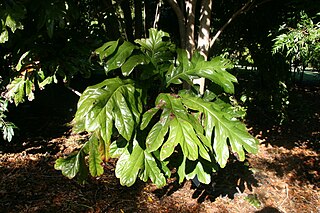
Athertonia is a monotypic genus of plants in the family Proteaceae. The sole described species is Athertonia diversifolia, commonly known as Atherton oak, athertonia, creamy silky oak or white oak. It is endemic to a small part of the Wet Tropics of Queensland, Australia. A relative of the macadamia, it has potential in horticulture and the bushfood industry.

Agathis macrophylla known as Pacific kauri, is a coniferous tree native to the islands of the southwestern Pacific Ocean in tropical humid lowlands and lower montane regions, notably in Fiji, Vanuatu, and the Santa Cruz Islands. The Pacific kauri is one of the largest and fastest growing species in its genus, and is important in forestry.

Agathis orbicula is a coniferous tree native to the island of Borneo. It is found scattered throughout tropical rainforests and Kerangas forests. It is commonly found on hills and plateaus. The species is facing a high risk of extinction due to its scattered distribution and the decline in quality of its habitat.
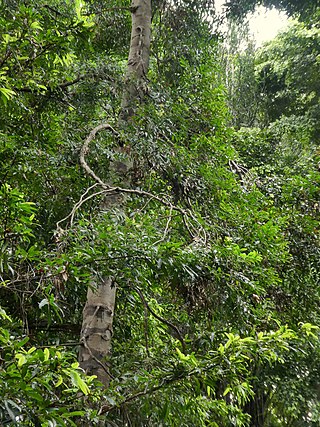
Agathis atropurpurea, commonly known as the blue kauri, and occasionally as the black kauri or purple kauri, is a species of conifer in the very ancient plant family Araucariaceae. The family was distributed almost worldwide during the Jurassic and Cretaceous periods, but is now mostly confined to the Southern Hemisphere. This species is endemic to a small part of northeastern Queensland, Australia.

Agathis microstachya, the bull kauri, is a species of conifer in the family Araucariaceae, endemic to Australia. It was described in 1918 by John Frederick Bailey and Cyril Tenison White. It is threatened by habitat loss.

Agathis moorei is a species of tree, endemic to New Caledonia. It occurs scattered throughout the main island in subtropical rainforest at altitudes of 250 metres (800 ft) to 1,000 m (3,300 ft). It is threatened by habitat loss.

Agathis ovata, the mountain kauri, is a species of conifer, genus Agathis in the family Araucariaceae. It is found only on the southwest Pacific island of New Caledonia. It is threatened by habitat loss.
Agathis robusta subsp. nesophila, the New Guinea kauri, is a subspecies of conifer native to the highlands of Papua New Guinea. It grows in the Eastern Highlands and Owen Stanley Range of eastern New Guinea and the highlands of New Britain at elevations of 900–1980 m. Although long known, it has only relatively recently (1980) been described as a subspecies of Agathis robusta. It is also known by the synonym Agathis spathulata. It is threatened by habitat loss.

Normanbya is a monotypic genus of palms containing the single species Normanbya normanbyi, which is known by the common name black palm It is endemic to Queensland, Australia and is threatened by habitat destruction.

Agathis borneensis, also known as Borneo kauri, is a species of conifer in the family Araucariaceae.

Buckinghamia celsissima, commonly known as the ivory curl tree, ivory curl flower or spotted silky oak, is a species of tree in the family Proteaceae. It is endemic to the tropical rainforests of northeastern Queensland, Australia.
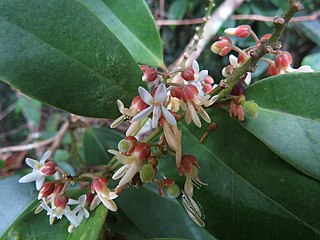
Xanthophyllum octandrum, commonly known as Macintyre's boxwood, false jitta, yellow boxwood or sovereignwood, is a slow-growing tree in the milkwort family Polygalaceae which has the potential to reach thousands of years of age. It is endemic to coastal northeastern Queensland, Australia.

Alstonia muelleriana is a tree in the dogbane family Apocynaceae which is native to southern Papua New Guinea and northeastern Queensland.

Pandanus solms-laubachii, commonly known as the swamp pandan, is a small tree in the family Pandanaceae which occurs in northeastern Queensland and possibly in Papua New Guinea. It is closely related to both Pandanus gemmifer and Pandanus grayorum.

Sterculia shillinglawii, commonly known as tulip sterculia or lacewood, is a tree in the family Malvaceae which is native to Papuasia and northeastern Australia.






